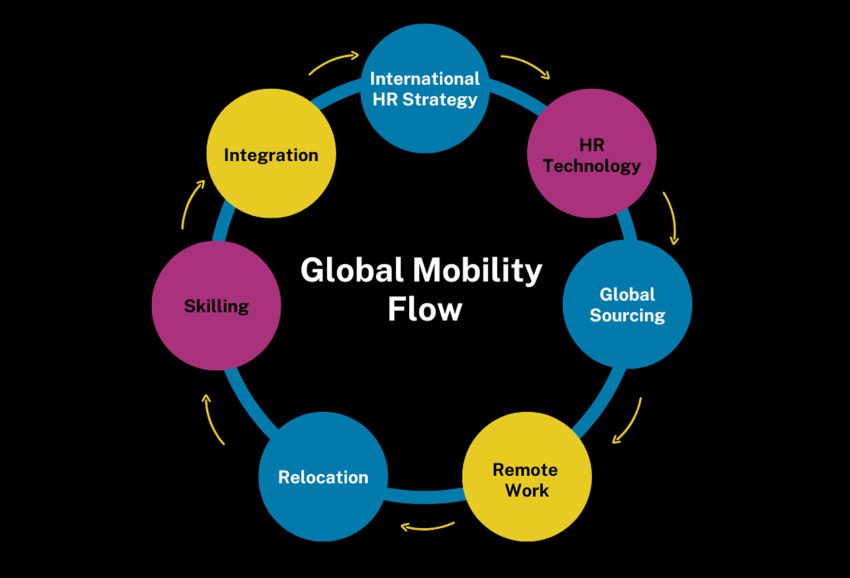Global mobility management is a vital component of modern HR and talent management strategies, especially for organisations with operations or ambitions spanning across borders. It refers to the processes and strategies involved in coordinating and supporting employees who take on international assignments, relocations, or transfers.
For HR professionals, global talent managers, and relocation specialists, the management of global mobility goes far beyond moving an employee from one location to another. It incorporates a broad range of responsibilities, including compliance with local labour laws, tax regulations, employee well-being, and fostering cultural adaptability.
Understanding what global mobility management entails and how it can benefit your organisation is key to building a dynamic and responsive workforce ready for international opportunities.
The Core Components of Global Mobility Management
At its foundation, global mobility management involves several key areas that must work seamlessly together. These include:
1. Compliance and Risk Management
When placing employees internationally, organisations face a diverse set of regulatory challenges. These include taxation obligations, work permits, visa requirements, and immigration laws. A structured mobility strategy ensures that both employees and employers remain on the right side of these regulations, avoiding potential legal or financial complications.
HR professionals must continuously stay informed about the latest developments in regional and global compliance requirements, as these regulations can frequently shift.
2. Employee Experience and Satisfaction
A well-run global mobility program is one that prioritises the experience of the employee. Moving for work can be a significant adjustment, often requiring support in understanding local customs, language, and culture. Providing resources such as cultural acclimatisation training, housing assistance, and access to local networks can help employees settle and thrive in their new environment.
The smoother the transition, the more likely employees are to maintain high levels of productivity and satisfaction during their assignment.
3. Cost Optimisation
For businesses, international assignments often come with a significant financial investment. These costs include housing allowances, relocation expenses, and tax equalisation. With efficient planning and the use of technology, costs can be optimised without compromising the quality of support for the employee. This can include analysing the best options for relocation policies and leveraging data-driven insights to anticipate and control expenses.
4. Talent Development and Retention
International assignments can be a powerful tool for personal and professional development. They provide employees with unique opportunities to build new skills, gain diverse perspectives, and contribute to strategic growth initiatives. Organisations with well-crafted global mobility programs are more likely to retain high-performing individuals, as these experiences foster engagement and loyalty.
Why Effective Global Mobility Management Matters for Organisations
The demand for international expertise and collaboration has never been higher. Whether it’s expanding into new markets or addressing skills shortages, businesses are increasingly relying on mobile employees to drive their objectives. But without a robust and well-structured approach to mobility management, these goals become harder to achieve.
A successful global mobility strategy not only aligns with organisational goals but also creates a transparent and supportive environment for employees. By addressing legal, financial, and cultural aspects it helps minimise disruptions and enables employees to focus on delivering successful outcomes.
Leveraging Technology for Streamlined Processes
The role of technology in managing global mobility cannot be overstated. Digital tools and platforms now enable HR professionals to automate time-intensive tasks such as payroll adjustments, visa application tracking, and compliance monitoring.
Advanced solutions also allow for real-time reporting and data centralisation, giving organisations the ability to track the performance and budget allocation of their mobility programs. This streamlining empowers managers to make informed decisions and enhance the overall effectiveness of their mobility initiatives.
A Key Driver for Success
Global mobility management is an indispensable part of fostering a productive and agile workforce. By effectively integrating compliance, employee support, cost management, and technology, organisations can not only overcome the challenges of international assignments but also unlock opportunities to boost growth, retention, and satisfaction across the board.
If you’re focused on creating a more efficient and employee-centric mobility program, harnessing the latest advancements in technology and strategy will set your organisation apart in an increasingly interconnected global economy.
